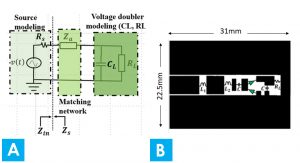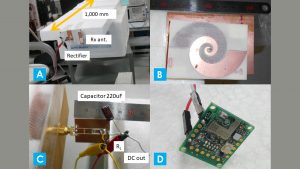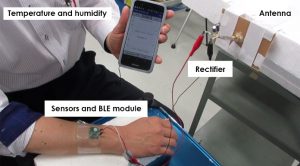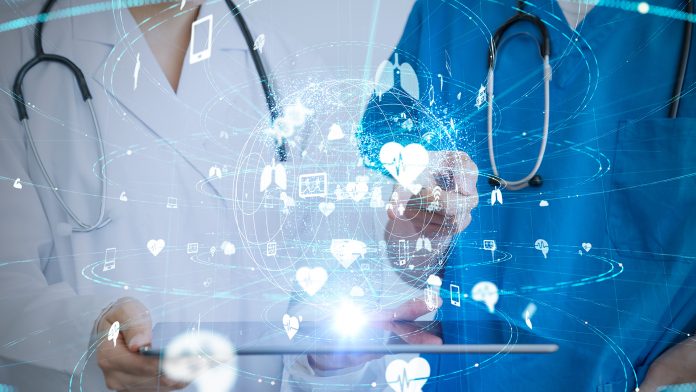Researchers have discovered a battery-less healthcare monitoring sensor platform that uses electromagnetic waves as a power source.
Thanks to the progress in sensor technology, many low-power-consumption devices have been made available, enabling the possibility of powering the sensors using environmental ambient energy. Photovoltaic, thermoelectric, and piezoelectric energy harvesting systems have been developed as technologies that can power low energy Internet of Things (IoT) devices. These technologies have their own inherent limitations, such as moving parts, fragility, and most importantly, the constant presence of the energy source (such as solar energy harvesting only being available during daylight hours).
On the other hand, radio frequency (RF) energy in wireless telecommunication systems such as RFID, WiFi cellular networks and broadcasts., represents a strong candidate for renewable energy harvesting. However, RF energy harvesting by using wireless telecommunication frequencies has a disadvantage because of the limited amount of RF power from the regulation and low conversion efficiency caused by the parasitic elements in the circuit.
In this research focusing on microwaves radiated from broadcasting and/or telecommunication that have been rarely reused, a battery-less healthcare sensor platform that uses electromagnetic waves as a power source is realised. In order to enhance the amplitude of the low power RF signal, a resonant circuit with impedance matching circuit was constructed in front of the booster circuit. The proposed system is composed of circularly polarised wideband planar antenna, rectifier circuit with impedance matching circuit, sensor module and Bluetooth low energy (BLE) module. For the feasibility study, the temperature and humidity sensors are attached on the surface of a human arm.

Rectifier and antenna designs
In this section, the rectifier and the antenna is designed and fabricated. Rectifier and antenna designs are validated using circuit and 2D electro-magnetic field (EM) simulator (ADS, Keysight), and 3D EM simulator (HFSS, Ansys), respectively Fig. 1(a) shows the circuit model of the rectifier. Voltage doubler is composed of the diodes and capacitors. The equivalent circuit of the voltage doubler is CL and RL parallel circuit. In order to realise the wide band impedance matching characteristic, the transmission line is inserted prior to the voltage doubler. The electrodes and metal lines are modelled by using EM simulator.
Whereas Fig. 1(b) shows the layout of the proposed rectifier. The substrate is the conventional FR4 which has a dielectric constant = 4.2. The surface mount type diodes, inductors, capacitors and resistor are placed on the layout. The total size is 31 mm x 22. 5mm.
The layout of the proposed log-periodic dipole antenna (LPDA) is designed to reduce the antenna size and the spiral structure is adopted. The size is 60 x 83 x 15 mm with reflector. The simulated maximum gain is 8.89dB in the +Z direction.

Fig. 2 (a) Photograph of the measured setup, (b) Photograph of the antenna, (c) Photograph of the rectifier, (d) Sensors and BLE module
Measurement results
Fig. 2(a) shows the experimental setup for temperature and humidity measurement on the human surface with battery less sensor system. The transmitted signal is license free band (920 MHz and 20dBm). The antenna, rectifier, and sensor and BLE module are in Fig. 2(b), (c) and (d). Tx (transmitter) and Rx (receiver) antenna is the same as that in Fig. 2(b).
The data of the surface temperature and humidity on the human body are transmitted to the smart phone at every two second as shown in Fig. 3. We can obtain the battery-less healthcare monitoring sensor platform.

Conclusion
The battery-less healthcare monitoring sensor platform that uses electromagnetic waves as a power source is realised. The 920 MHz RF signal is injected to the receiving antenna as a power source. The data of the temperature and humidity on the human body are transmitted to the smart phone every two seconds by using BLE module.
The authors would like to express thanks to Dr Mohamed M. MANSOUR, Kyushu University Japan, and Mr. Osamu TAKIGUCHI, ALSENS Inc., Japan for their help and support. This work was partly supported by VLSI Design and Education Center (VTEC), the University of Tokyo in collaboration with CADENCE Corporation and Keysight Technologies. This work was partly supported by KAKENHI, CREST, JSPS Japan and SCOPE. This work was also partially supported by the Grant-in-Aid for the Collaborative Research Program Based on Industrial Demand, JST. This work was partially supported by the Cabinet Office (CAO), Cross-ministerial Strategic Innovation Promotion Program (SIP), “An intelligent knowledge processing infrastructure, integrating physical and virtual domains” (funding agency: NEDO).
About the author
Haruichi Kanaya was born in Yamaguchi, Japan, in 1967. He received the B.S. (Physics) degree from Yamaguchi University in 1992 and 1994, respectively. In 1994, he became a Research Fellow (PD) of Japan Society for the Promotion of Science. In 1998, he was a visiting scholar at the Massachusetts Institute of Technology (MIT), USA. He is currently engaged in the study and design of RF CMOS System LSI, antenna and microwave devices, as a Professor in the Department of Electronics, Graduate School of Information Science and Electrical Engineering, and also System LSI Research center, Center for Japan-Egypt Cooperation in Science and Technology(E-JUST Center), Research Center For Advanced Biomechanics and Research Institute of Superconductor Science and Systems, Kyushu University. Dr Kanaya is a senior member of the Institute of Electronics, Information and Communication Engineers (IEICE) and the Institute of Electrical and Electronics Engineers (IEEE).
References
- Kanaya, H., Tsukamoto, S., and Hirabaru, D. et al. 2013. Energy Harvesting Circuit on a One-Sided Directional Flexible Antenna. IEEE Microwave and Wireless Components Letters, Vol. 23, Issue 3, 164-166, 2013
- Shinki, Y., Shibata, K., and Mansour, Mo. et al. 2017. Impedance Matching Antenna-Integrated High-Efficiency Energy Harvesting Circuit. Sensors, Vol. 17(8), 1763, 2017
- Mansour, M.M., and Kanaya, H. 2019. High-Efficient Broadband CPW RF Rectifier for Wireless Energy Harvesting. IEEE Microwave and Wireless Components Letters, Vol.29, Issue, 4, 288-290, 2019
- Mansour,M.M., and Kanaya, H. 2019. Efficiency-Enhancement of 2.45-GHz Energy Harvesting Circuit Using Integrated CPW-MS Structure at Low RF Input Power. IEICE Trans. Electron, Vol.E102-C, No.5, 399-407, 2019
- Mansour, M.M., and Kanaya, H. 2019. Novel L-Slot Matching Circuit Integrated with Circularly Polarized Rectenna for Wireless Energy Harvesting. Electronics, Vol. 8, 651, 2019
- Mansour, M.M., Polozec, X Le., and Kanaya, H. 2019. Enhanced broadband RF differential rectifier integrated with archimedean spiral antenna for wireless energy harvesting applications. Sensors, Vol.19 (3), 655, 2019
Professor Haruichi Kanaya
Department of Electronics, Graduate School of Information Science and Electrical Engineering
Kyushu University
kanaya@ed.kyushu-u.ac.jp
http://yossvr0.ed.kyushu-u.ac.jp/
Please note, this article will also appear in the first edition of our new quarterly publication. Subscribe to our updates for free here.







